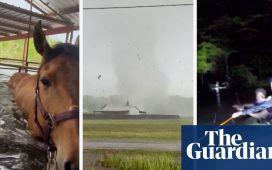More than a century after it was published, the article reads like slapstick comedy from the silent-movie era.
It was May 1904. A street cleaner had inadvertently left a wrench beside a fire hydrant. Then a mischievous boy came along. What could go wrong?
The New York Times described the child — “a diminutive messenger boy, carrying a big suit case” — as well as the wild rumpus that ensued: “In less than a minute, the adjoining territory was a seething flood. The boy calmly turned on the water full force, threw the wrench beyond all chance of recovery, (down the sewer at the corner) and then coolly sat down on the suit case to watch the results of his mischief.” A policeman “bravely endeavored to move the faucet with his bare hands.” It was useless. “Get a cork!” the boy taunted.
“Busy Street Deluged,” the headline read. “A Little Boy’s Prank.”
The exuberant photographs you see here were shot by The Times throughout the 20th century, running with captions such as “Cooling Off City-Style” and “AH! THAT FEELS GOOD!” One caption writer was even moved to pronounce the fire hydrant as “the lifeline of summer, spewing cooling excitement to all around it.” That is certainly true. But even after the city began distributing sprinkler caps in the 1950s to reduce the amount of wasted water, fireplugs continued to be opened illegally, becoming a source of tension and sometimes violence.
Much of the rancor stemmed from the fact that New York’s poor ranked low among the city’s priorities — and knew it.
During the catastrophic days of August 4-13, 1896, it was as hot as 120 degrees inside the tenements on the Lower East Side of Manhattan. At least 1,300 people died in New York City from the heat, many of them immigrants working 60 hours or more a week. The mayor had declined to lift the ban on sleeping in parks and didn’t assemble his team to strategize until the 10th day of the heat wave. Theodore Roosevelt, then the city’s 37-year-old police commissioner, became something of a hero by handing out ice in alleys behind the tenements. Later, he remembered in his autobiography the “gasping misery of the little children and of the worn-out mothers” and compared the scene to a cholera epidemic.
In June 1925, another brutal heat wave hit. Hundreds of thousands of New Yorkers fled their homes, often with their bedding, to sleep in parks, on beaches, even in the grass by the roadside. The opening of hydrants was still a new enough phenomenon that The Times took pains to describe it in detail: “Small groups of children in bathing suits would gather about a fire hydrant. Then some one would get a wrench and open the hydrant and a stick would be placed in the nozzle to cause the water to spurt skyward and the children would jump under the shower.”
The fire commissioner feared that a fire would break out and that water pressure would be insufficient to combat it. He asked the police to guard the hydrants.
In the years that followed, the situation only worsened.
On June 9, 1933, about 400 young people demonstrated in front of the police station on West 47th Street, protesting officers for shutting down hydrants down during heat waves.
By July 4, 1961, tempers and temperatures were such that residents hurled rocks and bottles at officers when they arrived with wrenches. “Yesterday,” The Times reported, “Police Headquarters issued air raid helmets to all members of the force with orders to put them on before raiding illegally opened fire hydrants.”
There’s a boisterous scene with a flowing hydrant in Spike Lee’s 1989 movie, “Do the Right Thing.” The level of detail is striking, starting with the real-life Times headline shown in the film: “Yes, It’s Hotter, It’s Muggier, and, Yes, You’re Going Crazy.” You see a fireplug opened with a wrench. You see two young men rubbing the tops off cans on the sidewalk so they can use them to aim the water like a fire hose.
More important, you see the same thing you see in these images from The Times’s archives: how drastically water can transform a neighborhood that’s desperate for relief.
